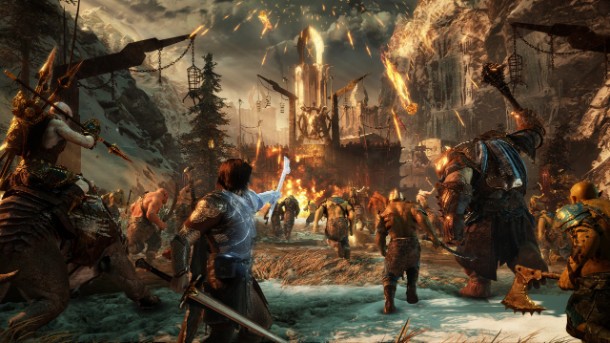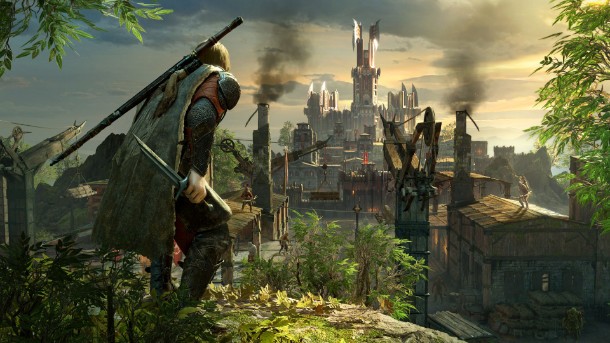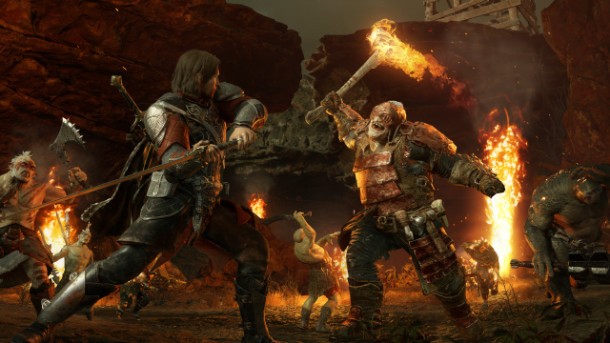Extended Hands-On Impressions With Middle-earth: Shadow Of War

As you have likely already seen, Middle-earth: Shadow of War is on the cover of this month's issue of Game Informer. To get as full of a picture of the game as possible, a team of GI editors flew out to the offices of Monolith to not only meet with multiple key members of the development team, but also play several hours of the game.
Following our lengthy gameplay session, senior previews editor Matt Miller and I sat down to discuss our overall impressions of Middle-earth: Shadow of War. You can read our conversation below, and for more on the game, be sure to visit our coverage hub.
Matt: Brian, you and I recently returned from a lengthy visit to Monolith, where we got to play several hours of a near-final version of Shadow of War. Top-level thoughts? What did you think of what you played?
Brian: I think my biggest takeaway was how my time with Shadow of War reminded me of the things that truly worked with Shadow of Mordor – the thrill of the Nemesis system, the smooth, fluid combat, and, of course, the big open-world to explore. It feels like all of the things that Shadow of Mordor did well, Shadow of War does better.
Matt: It's funny that you frame it that way. For me, my sense of the game formed in the opposite way. I was struck by how a lot of the small things that I didn't like in Shadow of Mordor feel a lot better in this new game – and it was only after I noticed those things that I began to once again fall into the groove of enjoying that awesome Nemesis system. But, any way you cut it, the game makes a strong first impression. What did you think of the way combat feels?
Brian: The combat was one of my favorite parts of Shadow of Mordor, and Shadow of War's is pretty close to that. However, the upgrades that you get and the new heavy attack that uses Celebrimbor's glaive give you more options when attacking. Again, though, every exciting moment in the game seems to revolve around the Nemesis system. The combat is great, but the best parts of the battles are when those relationships you build with the various orcs manifest in the heat of battle – either in a positive way or a negative way for you.
Matt: Yeah, I really like the way the Nemesis system feels deeper now, and the enemies (and allies) more individualized. We're going to talk a lot about this later in the month, but as I played, I was constantly trying to gauge if things had actually gotten a little too chaotic. As a rule, a sense of wild abandon and insanity in the midst of a big combat sequence can be thrilling, but Shadow of War really pushes right up to the line on that. Did you ever have times that you felt like you'd just lost control?
Brian: Oh, absolutely. I had one time where I was in the middle of a fortress assault in Gorgoroth and I thought I had it pretty well under control, but then a new group of archers started raining arrows down onto my team and me, and drakes and caragors popped up seemingly out of nowhere. It actually got to the point where I was downed and as the orc went in for the killing blow, one of my allies swooped in and saved me. I love that the chaos kind of goes both ways.
Matt: We were in the same room playing separate playthroughs of that same content, and I remember hearing you scream about how quickly things had gone wrong at that point. It made me laugh, right up until the same sort of thing happened to me, but in a completely different context. I was rolling through those control points without much trouble, but all of a sudden my most powerful orc ally got ticked off at me because, apparently, I killed his blood brother. How was I supposed to know? In a split second, the entire battle went sideways. He murdered my mount, killed off several of my other allied orcs, and sent me running to find a rat from whom I could drain some health. I managed to squeak through that assault, but there were definitely times it felt overwhelming. I think some players are going to love that sensation; for others, honestly, it might be a bit much.

Brian: I agree, but that sense of chaos is what makes the game work and what makes the Nemesis system so cool. Speaking of chaos, the boss battles with the Nazgûl are nearly as frenzied as the fortress assaults are, just on a much smaller, more focused scale. We saw three of them, how did they strike you?
Matt: The ringwraith fights are certainly a big change for the game. So much of the franchise is about systemic gameplay and emergent situations. In contrast, the ringwraith boss fights are much more structured and static in form. You can still bring all your tricks and special moves into the fray, but the battles themselves feel more like traditional boss fights - even as the Nemesis-originated conflicts (like those in the fortress assaults) continue as well. We should take a step back and discuss Monolith's broader decision to offer individual identities to the different ringwraiths. What's your take there?
Brian: Yeah, I'm not a diehard Tolkien fan, but from what I understand, nearly all of the ringwraiths were left unnamed in the source material, so Monolith had some major freedom in granting new identities to these characters. It seems that Monolith definitely wanted to establish the common theme that these were at some point all altruistic humans who were tempted by the power of Sauron, and the gamble didn't pay off. Now they're slaves to the dark lord. I do like that we learn their backstories after defeating them through some pretty cool cinematics.
Matt: As a gameplay experience, it certainly makes the idea of ringwraith boss fights more compelling and distinct one from another, but hardcore Tolkien fans are going to have to pause and take some deep breaths, and tell themselves that everything is going to be alright; I think the developers we spoke with at Monolith are the first to acknowledge that they are taking liberties with some aspects of the fiction, and having backstories and unique armor and weapons for each of the Nazgûl just makes for a more compelling gameplay loop. I mean, the other ringwraiths we played against are pretty important characters in the broader Middle-earth setting. Did you have a favorite of the Nazgûl fights?
Brian: I think that Suladân was probably my favorite, just because I felt like the chaos wasn't too much. He has a bunch of energy blasts he can send your way, but overall, your tactics from standard conflicts still work the majority of the time. Isildur uses necromancy to summon dead soldiers to fight alongside him, giving you an intense, but familiar combat loop. However, with Helm Hammerhand, I felt like there was so much going on that the fight felt out of my control as I rolled to avoid drakes, ghûls, and Helm's wild hammer swings.
Miller: Suladân is a concocted character, but two of the other fights we saw - Helm Hammerhand and Isildur - are pretty major characters. Reimagining what happened to Isildur, in particular, is a pretty bold idea for Monolith to attempt. Whether you agree or disagree with that creative decision, I'm certainly with you on the coolness of those cinematic sequences. I love the way they add this extra layer of tragedy to the story of the Nazgûl, and show off the ways these guys went from mighty kings of humanity to dominated minions of Sauron.

Brian: Speaking of liberties taken by Monolith and creative approaches to the lore, as a big fan of Tolkien, what do you think about ideas like Shelob taking a feminine form, or the concept of a New Ring? These seem like major departures from the source material.
Miller: That's absolutely true. I've read Tolkien since I was a kid, and a lot of that stuff feels weird at first. I'm not going to try and argue anyone out of their opinions on the matter, but I will say this: Shadow of War, and its predecessor Shadow of Mordor, already have done things that feel pretty unusual and brazen within this beloved fictional landscape. But it's usually in pursuit of particular goals in storytelling and gameplay – and that's the case with both Shelob as a woman and the New Ring. Shelob's human form gives Monolith a way to make that character a more communicative and nuanced figure, and she is able to play a much bigger role in dialogue and storytelling. Is the best way to do that to make her into a beguiling woman? Players are going to have to decide that for themselves. Similarly, at first glance, the idea of a New Ring of power really rubbed me the wrong way. The rings are this foundational aspect of Middle-earth storytelling – how can this video game all of a sudden proclaim there's another one in the mix, and that it rivals the One Ring in strength. But, examined as a game mechanic, the New Ring introduces all sorts of interesting elements surrounding domination, growing power, and unique runes that change gameplay. So, for me personally, I think I've adopted the perspective of letting the game be the game. Is it canon? That's maybe not the important question. Once we've seen the game in its entirety, the question becomes: is the game better for these elements? And that's not a judgment I'm quite ready to pass. However, we did get to see the entirety of that opening cinematic, which introduces the New Ring, Shelob, and several other important things, and the polish and excitement of those scenes are hard to argue with. What was your take on that opening?
Brian: As someone who isn't super well-versed on the lore, I thought it was a decent setup for the story. We see the New Ring get forged, and Celebrimbor spill his power into it (giving a convenient set up for why you're suddenly less powerful than you were at the end of Shadow of Mordor), and then Shelob's appearance gives us a sense of how coveted this New Ring is, as she does everything in her power to steal it away from Talion. After that, the game dumps the player into the open world of Minas Ithil.
Miller: It was neat to see Minas Ithil under assault (which, by the way, is another well-meaning small liberty being taken with the story, as they're moving around when Minas Ithil first got captured). That opening run at the human Gondorian city does an excellent job of tutorializing the basic concepts, and it also gets right into some storytelling, with new characters you're meeting who are trying to defend the city. I like that the entire opening section of the game has players running around this big city that is reminiscent of Minas Tirith from the books and movies, even as we know that the whole place is about to get trashed by the bad guys. But we also had a chance to jump ahead and run around a bunch in the open world, much later in the game, in this hellblasted landscape called Gorgoroth. Did you have any cool things you encountered there?
Brian: Yeah! I found that if I sent a dominated orc to infiltrate an enemy war chief's forces, he must first prove himself worthy of that war chief by competing in the fighting pits. This throws the orc into a literal pit as he faces off against another orc in a fight to the death. The odds can stack pretty heavily against you; in one battle my guy was outmatched by about seven levels, while in another, the opposing orc brought a small posse of allies with him. It's not always a fair fight, but through watching several of these play out, I quickly learned that the underdog always has a fighting chance. It's thrilling to watch these two computer-controlled characters duke it out, particularly when you consider what is on the line - if you win, you have an undercover orc inside the walls of the fortress who will betray the war chief when the time is right, but if you lose, that orc is dead and gone forever. I spent so much time during my demo making sure I had multiple orcs on the inside to help out when I finally decided to jump into the fortress assault. What about you? What was your favorite thing you stumbled upon?

Miller: I think my favorite discovery out there in Gorgoroth was this quest line about a Balrog being raised up from the pit. While it's not the same one, this Balrog is the same kind of being as the one that Gandalf confronts on the bridge in the famous "You shall not pass!" scene. In order to not make this whole sequence seem ridiculous, Talion and Celebrimbor immediately acknowledge that they're not a match for bringing this thing down. But then the forest spirit named Carnan is brought into the fight, and there's this whole sequence of this powerful spirit changing into a different form as she fights the Balrog, and Talion is along for the ride. It's a pretty crazy sequence. It was fun to both be playing the same demo, in the same room, but you had this completely different experience than I did. But I know we were both enjoying the new traversal options.
Brian: Absolutely. Talion's new super-fast sprint drains his focus, which is handy in battle, but man, do you get some serious speed when you use it! It's nice to be able to breeze through some of those longer hikes when you're just trying to get from point-a to point-b and fast-travel isn't an option.
Miller: The sprint options are great, but I think I personally notice the difference even more in climbing. One of Talion's other new abilities lets you tap the bottom face button and zip up a wall or cliff. It makes the game's many vertical planes much less imposing and much more fun.
So, big takeaways? What's your current sense of Shadow of War after playing for several hours?
Brian: I'm more excited for the release than I was before getting this hands-on time. I was quickly reminded how easy it is to fall back into the addicting gameplay loop of the Nemesis system, and the fortress assaults are just crazy in all the right ways. I'm also excited for how the Shadow Wars stuff after the final boss battle gives further meaning to the Nemesis system towards the end of the game - something Shadow of Mordor really struggled with.
Miller: I feel like Shadow of War addresses so many of the small problems from its predecessor, and I had a blast exploring the world. I need to spend more time with the game before I make a call on its overall combat balance, progression loop, and narrative, but the game leaves an excellent early impression. I also have to say that I'm sort of blown away by the scope of the game -- this thing is way bigger and more complex than I think a lot of people are expecting. There are five big regions in this game, and while I haven't seen all of them yet, Monolith claims that every one of those regions is bigger than either of the two big regions from the last game. Shadow of Mordor was a complex game, but Shadow of War feels much more robust in almost every system, and much more surefooted in its presentation. While I can't be confident I'm going to be completely on board with every crazy change they're making to Middle-earth fiction, that's sort of fine with me. I'd rather have the team do something surprising and crazy than feeling so shoehorned that they can't take any creative license. We'll see how it all shakes out, but I came away very hopeful that Shadow of War is going to be an impressive epic.
Click on the banner below to enter our constantly-updating hub of exclusive content.

Get the Game Informer Print Edition!
Explore your favorite games in premium print format, delivered to your door.
- 10 issues per year
- Only $4.80 per issue
- Full digital magazine archive access
- Since 1991










